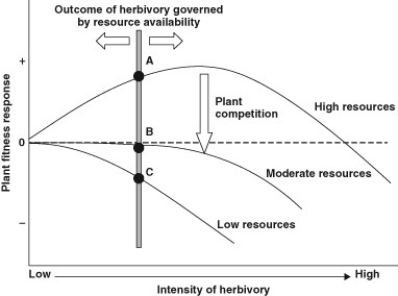Use the figure to answer the following question. The figure proposes a combination of a top-down and bottom-up model (a hypothesis) to describe the variable effects of biological control herbivores on the fitness (growth and reproduction) of an invasive, non-native plant, spotted knapweed (Centaurea stoebe) . These herbivores include multiple insects that were first studied in the plant's native home range in eastern Europe, where the plant is not dominant in grassland communities and does not pose a problem to land managers and conservationists. Many insects there were found to consume the plant's tissues, including stems, leaves, and seeds, and some were very host specific and were not found to attack plants other than C. stoebe. Several insects were subsequently transported and released in an attempt to reduce densities of this non-native and problematic weed in the United States. The y-axis shows C. stoebe plant fitness, and the x-axis represents the intensity of herbivory by the insects, from low to high. As the vertical shaded bar is moved along the x-axis, the ultimate effect of herbivory (now A, B, and C) on plant fitness can change based on its intensity and also may depend on the other factors. The horizontal dashed line represents no predicted change in fitness under the effects of varying intensity of herbivory, plant competition, and soil resources available to the plant (such as nitrogen or water) , while the three solid lines represent other possible outcomes.
The figure proposes a combination of a top-down and bottom-up model (a hypothesis) to describe the variable effects of biological control herbivores on the fitness (growth and reproduction) of an invasive, non-native plant, spotted knapweed (Centaurea stoebe) . These herbivores include multiple insects that were first studied in the plant's native home range in eastern Europe, where the plant is not dominant in grassland communities and does not pose a problem to land managers and conservationists. Many insects there were found to consume the plant's tissues, including stems, leaves, and seeds, and some were very host specific and were not found to attack plants other than C. stoebe. Several insects were subsequently transported and released in an attempt to reduce densities of this non-native and problematic weed in the United States. The y-axis shows C. stoebe plant fitness, and the x-axis represents the intensity of herbivory by the insects, from low to high. As the vertical shaded bar is moved along the x-axis, the ultimate effect of herbivory (now A, B, and C) on plant fitness can change based on its intensity and also may depend on the other factors. The horizontal dashed line represents no predicted change in fitness under the effects of varying intensity of herbivory, plant competition, and soil resources available to the plant (such as nitrogen or water) , while the three solid lines represent other possible outcomes.
(D) G. Knochel and T.R. Seastedt. 2011. Reconciling contradictory findings of herbivore impacts on spotted knapweed (Centaurea stoebe) growth and reproduction. Ecological Applications 20(7) :1903-1912.
What is the model's prediction for C. stoebe plant fitness when growing under high soil resource conditions?
Definitions:
Attributional Dimensions
The perceived reasons or causal explanations people assign to events and behaviors, influencing their reactions and attitudes.
Unipolar Depression
A form of depression characterized by a persistent low mood and lack of interest in activities, without the manic episodes of bipolar disorder.
Bipolar Disorders
A group of mood disorders characterized by drastic mood swings that include emotional highs (mania or hypomania) and lows (depression).
Problematic Emotional Extremes
Experiencing emotions that are excessively intense or out of proportion to the situation, which can interfere with daily functioning.
Q2: Use the following figures to answer the
Q10: If the sun were to suddenly stop
Q13: Which statement about dispersal is false?<br>A) Dispersal
Q27: In July 2008, the United States had
Q27: Which of the following factors could cause
Q36: The following steps refer to various stages
Q43: Through trial and error, a rat learns
Q54: Forming new long-term memories is strikingly disrupted
Q59: _ has no value until it is
Q65: Displays of nocturnal mammals are usually _.<br>A)